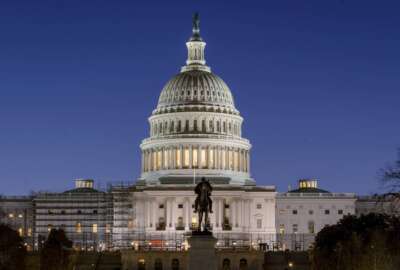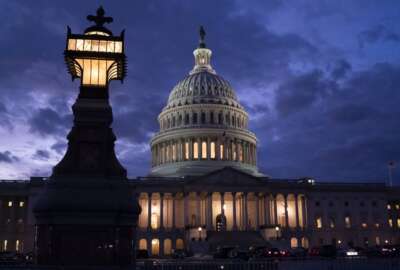
Senate confirmation process dragging on longer with every administration
Presidents make sure their and their party's policies are carried out in large measure by whom they appoint. Each time, though, it seems like the confirmation p...
Best listening experience is on Chrome, Firefox or Safari. Subscribe to Federal Drive’s daily audio interviews on Apple Podcasts or PodcastOne.
Presidents make sure their and their party’s policies are carried out in large measure by whom they appoint. Each time, though, it seems like the confirmation process goes slower and slower. For a look at how things stand now for the Biden administration, the Federal Drive with Tom Temin turned to someone who counts these things. Anne Joseph O’Connell is a Stanford Law School professor and a senior fellow of the Administrative Conference of the United States.
Interview transcript:
Tom Temin: Ms. O’Connell, good to have you on.
Anne Joseph O’Connell: Thanks for having me.
Tom Temin: Right. So let’s talk about the long term trends here. And you see comparisons and numbers to date counts for different administrations going back many years. Is it in fact actually getting longer, more dragged out and slower?
Anne Joseph O’Connell: Yes, it is. Both on the nomination side and on the confirmation side, if you look from President Reagan, all the way through to President Biden.
Tom Temin: Got it. And the Plum Book is actually expanded a little bit, too, in that period of time.
Anne Joseph O’Connell: Yes, there was an effort by Congress in 2012 to cut Senate confirmation from about 170 positions. And so that helped for a bit, but Congress has also added positions that require Senate confirmation.
Tom Temin: And beyond the Senate confirmed, then it becomes the administration’s problem to nominate people for the appointed, but not Senate confirmed, there’s about a couple thousand of those, right?
Anne Joseph O’Connell: Yes, that’s right. So there’s about give or take 1,200 Senate confirmed jobs, and several thousand below that that are also political slots that don’t require Senate confirmation.
Tom Temin: All right. And so where does the Biden administration stand at this point, relative to where it should be and relative to say, Trump and Obama and Bush at the same period?
Anne Joseph O’Connell: So the benchmark is critical. So if you compare to President Trump, at the one year or the 13 month mark, President Biden was doing better than President Trump in terms of number of nominations for these key agency jobs. But of course, I don’t think that President Trump should be the benchmark. So you could look to President Obama, but President Obama was also quite slow and President Obama had a higher percentage of his nominees were confirmed. He had more nominees submitted to the Senate than President Biden. So President Biden is slow. And its in party on the White House and its in part on the Senate.
Tom Temin: Could one of the reasons be here, and I was just looking at this nomination that crashed and burned of Sarah Raskin for the federal banking regulation job. And you could say that some of her views were a little bit far even for Democrats to accept. And this is not just a Biden administration phenomenon. But I remember as far back as Carter, even I remember nominating just among the nominees, people that were way out of what even a friendly Senate could accept, which we found in this case. Could it be that the more presidents do that, the more suspicious the Senate gets about the rest of the nominees that might be totally normal?
Anne Joseph O’Connell: So I think there could be an argument that when the rules changed in the Senate, in November of 2013, from requiring 60 votes for a nomination to get to a confirmation vote to a majority, is that the White House when putting forward nominees cared less about consensus across the aisle because you needed at least 60 votes. I don’t know if that’s true, because if you look at the 130 recorded votes, since the start of the Biden administration, a majority of them have more than 60 affirmative votes. So I think even those nominees that get to a recorded vote, and the number of recorded votes is increasing, you’re still seeing support across the aisle.
It is a tough Senate, you can’t lose one vote if you have no Republicans on board. Now there have been several nominations that have gone through, because there was some loss of Democratic votes. But there were some Republican votes to get the necessary majority.
Tom Temin: Right. So the habit of every president to nominate people that are sort of out there isn’t really a bearing factor in all of this?
Anne Joseph O’Connell: I think that’s right, I think and I think that part of the delay actually may be, which I think is a worthwhile source of delay, is that this administration is trying to diversify who’s in charge of our federal agencies. And we see some remarkable statistics about who’s coming in to federal agency leadership. And if these are people who have not been the classic in and outers in who had close terms, it takes longer to find those people it takes longer to vet those people, but then you have a much more diverse, much more interesting leadership for the federal government.
Tom Temin: We are speaking with Anne Joseph O’Connell. She’s a Stanford Law School professor and a senior fellow of the Administrative Conference of the United States. And this diversity issue gets to another kind of human capital cost of accepting nomination to a federal job. I’ve seen the forms. And the higher you go, the more you literally need a law firm to be able to look into your affairs to be able to be worthy of this, and people may be totally worthy. But nevertheless, you have these forms and so forth. Has that gotten worse over the years, and the fact that it just takes so long that people don’t want to bother, and therefore it’s harder to find people willing to do this?
Anne Joseph O’Connell: I think it’s gotten worse in the sense that people’s financial lives have become more complicated. And the forms require a lot of information. The key is that it hasn’t gotten better. And the 2012 act that cut Senate confirmation from about 170 positions, established a working group to streamline the paperwork process. And the working group bipartisan came up with a set of really impressive recommendations. And sadly, since that report was issued in November 2012, almost nothing’s been implemented.
Tom Temin: Right. Well, that kind of happens a lot in Washington does it with reports with lots of recommendations. And a moment ago, you mentioned that the benchmark of the Trump administration relative to Biden, is probably not a good benchmark, is that because as a total outsider, relative to other politicians that have come into the job, even other Republicans that maybe know more people that are likely to be confirmed and know their way around Washington relative to what the Trump team might have been aware of getting to Washington?
Anne Joseph O’Connell: I don’t think it was who was in the pool. I think it was that President Trump came in and noticed two things for him. The first thing that he noticed is he thought that there were a lot of political appointments, he thought there were too many political appointments. He viewed some of them as unnecessary, and he announced publicly that he wasn’t going to fill them. And the second thing for President Trump, as he said he loved his acting’s right under the Federal Vacancies Reform Act of 1998, in a lot of agencies, though, not all agencies like the Merit System Protection Board, but in many agencies, President Trump could use acting officials for long periods of time in place of Senate confirmed ones.
Tom Temin: Of course, that might be easier and smoother to do but does it really get your agenda accomplished?
Anne Joseph O’Connell: Well, President Trump believes that he had more sway over his actings than over his confirmed appointees. Now, of course, he may have had more sway over his acting secretary of Homeland Security, for example, but I think acting officials have less sway over the people beneath them. So if you’re thinking about policy implementation, I do think having Senate confirmed officials allows you to push your policy agenda farther.
Tom Temin: And just analyzing where the Biden administration does stand at this point, how many openings roughly are there?
Anne Joseph O’Connell: So the Washington Post in the Partnership for Public Service run an appointee tracker, they do this in all administrations. They’re tracking about 800 Senate confirmed slots, so not all of them, but the ones they think are the most relevant. And of those approximately 800 slots, President Biden has slightly over 300 confirmed. He has over 180 nominations either pending with the Senate or announced and not yet sent to the Senate. He’s using about 190 term or holdover appointees. And what does this mean? This means that there’s still about 120 jobs out of the 800 that are being tracked, that lack even in announced nominee and this is as of mid-March.
Tom Temin: Got it, then if you look at it in those terms, it seems like a really heavy lift for an administration. And this was a well-prepared administration. They had their teams in, and you knew they had their policy priorities lined up, you know, the day before the inauguration. Remember those stacks of executive orders, they just didn’t get written that morning, you know, while everybody was getting dressed for breakfast. So it’s a little surprising that they weren’t more together on these 800.
Anne Joseph O’Connell: So I think there are several factors at play. I mean, the first is the election and the certification of the election. So it took the General Services Administration several weeks to certify the election for President Biden. That meant that money, vetting was slowed down. I think the delays are more than the three weeks. Second, there has been some reports about issues with regard to the Presidential Personnel Office and some tension within that office. The director of Presidential Personnel has left, there’s a new director of Presidential Personnel. And then third, although not spoken in the same way as President Trump but President Biden’s team also knew the value of acting officials. So on day one I wrote for the Brookings Institution, they had unconfirmed, completely legal under the Federal Vacancies Reform Act people in various what are known as first assistant slots in federal agencies. And under the Vacancies Act, it allowed those first assistants to be the acting official while the appointments process churned. So while there may be these big gaps in confirmed leadership, there are people carrying out the functions of those jobs largely.
Tom Temin: I call those the PTDOs is performing the duties of.
Anne Joseph O’Connell: Exactly.
Tom Temin: Well, let’s hope they have good fidelity to what they’re supposed to be doing because they’ve got a lot of work and a lot of influence.
Anne Joseph O’Connell is a Stanford Law School professor and a senior fellow of the Administrative Conference of the United States, among other things.
Copyright © 2024 Federal News Network. All rights reserved. This website is not intended for users located within the European Economic Area.
Tom Temin is host of the Federal Drive and has been providing insight on federal technology and management issues for more than 30 years.
Follow @tteminWFED





